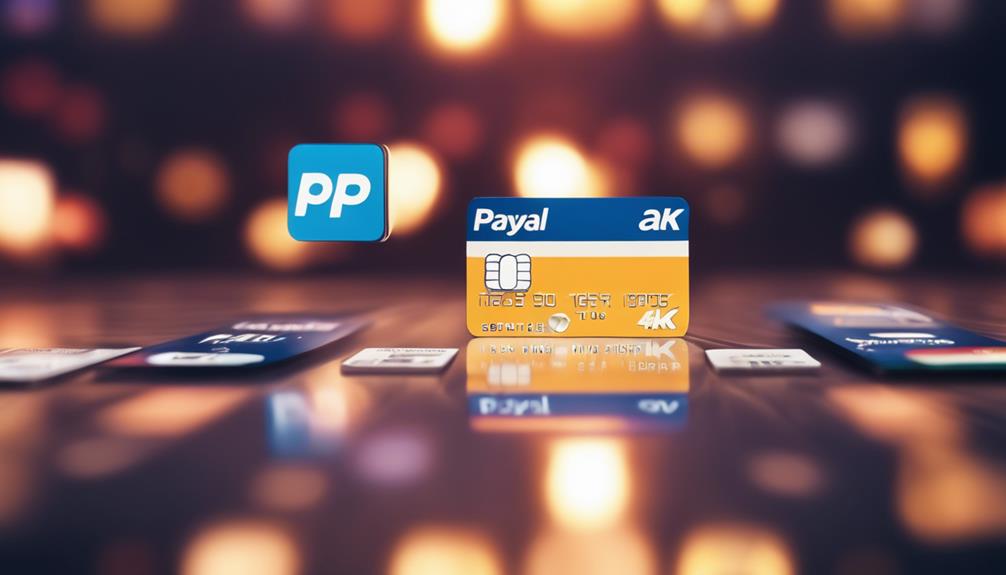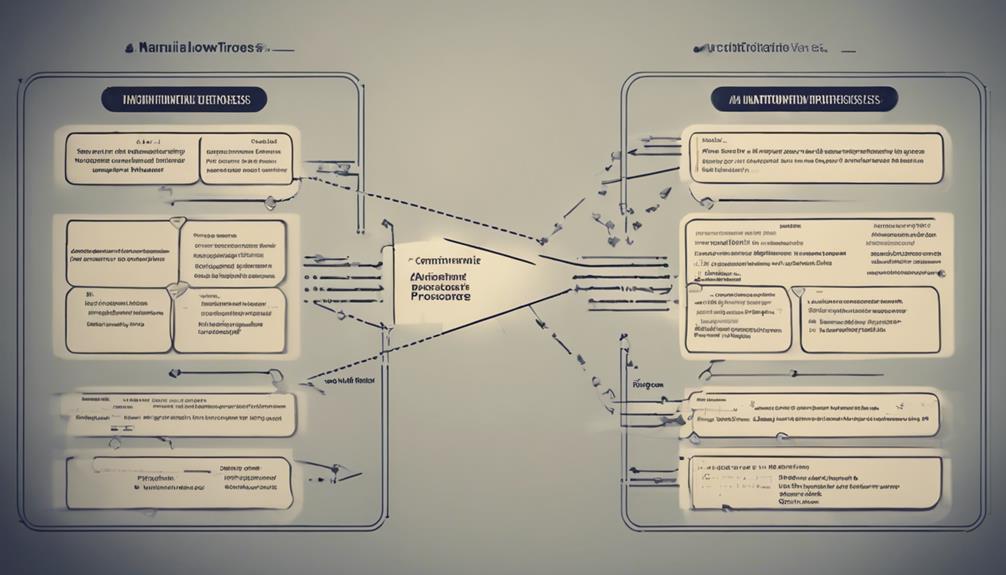Credit Card Processing & ISOs
Exploring the Landscape: Comprehensive Overview of Credit Card Processing Solutions
Step into the intricate world of credit card processing solutions, uncovering the pivotal players and mechanisms driving global transactions.

Begin a journey through credit card processing solutions to uncover the intricate mechanisms driving daily transactions worldwide. Explore the roles of key players like Visa and Mastercard, ensuring seamless fund transfers and secure communications. Understand how issuers, acquirers, and payment processors work in tandem to facilitate smooth transactions. Delve into the pivotal role of credit card networks in setting global transaction standards. Investigate the significance of payment gateways in encrypting data and enhancing customer experience. Unravel the support provided by merchant service providers and independent sales organizations in simplifying payment processes. Discover the evolving trends shaping payment facilitation for businesses.
Key Takeaways
- Payment processing involves card associations, banks, and processors.
- Innovations focus on security, efficiency, and customer experience.
- Issuers profit from interest charges; acquirers from processing fees.
- Credit card networks ensure secure communication and transaction processing.
- Payment gateways offer secure data transmission and multiple payment methods.
Payment Processing Cycle Overview

In the payment processing cycle, cardholders initiate transactions that set off a chain of interactions among various entities involved in the payment ecosystem.
When you make a purchase, the transaction journey begins with your action. The issuing bank then steps in to authorize the transaction, ensuring the necessary funds are available.
Subsequently, the funds are transferred to the acquiring bank of the merchant you're buying from. Payment processors are crucial in managing the flow of this transaction between banks, ensuring that the process isn't only smooth but also secure.
Card associations like Visa and Mastercard facilitate the interchange of information and funds between all these entities, enabling a seamless payment experience for you as the cardholder.
Each entity in this cycle plays an essential role in ensuring that the transaction is completed successfully, ultimately leading to a hassle-free and efficient payment experience for you.
Key Players in Credit Card Processing

When considering the key players in credit card processing, it's vital to acknowledge the industry leaders who shape transactions through their innovations.
These players drive the evolution of payment processing solutions, ensuring efficiency and security in transactions.
Understanding their roles and contributions is important for maneuvering the complex landscape of credit card processing.
Industry Leaders in Processing
Among the key players in the credit card processing industry are major card associations like Visa and Mastercard, essential in facilitating global transactions. These industry leaders work in tandem with acquiring banks, responsible for processing credit card payments for merchants, and issuing banks, which provide credit cards to consumers.
Payment processors act as the intermediary, ensuring the secure transfer of funds between acquiring and issuing banks. Additionally, card associations set up the network and regulations for processing credit card transactions worldwide. Together, these entities form the backbone of the Payments Industry, enabling the seamless flow of funds through the credit card ecosystem.
Innovations Shaping Transactions
Explore how key players in credit card processing are driving forward innovative solutions to shape and enhance transactions in the modern digital landscape.
From financial institutions to card networks, the industry is constantly evolving to meet the demands of the global economy. Security measures in data processing and transaction technology are advancing to guarantee safe payments.
Collaborations between key players like acquiring banks, issuing banks, and payment processors are vital in implementing these innovative solutions. Emerging trends focus on streamlining processes, improving efficiency, and enhancing customer experience.
With card associations setting standards for credit card transactions, the industry continues to adapt to meet the evolving needs of businesses and consumers in an ever-changing financial landscape.
Understanding Issuers and Acquirers

Issuers, as financial institutions, provide consumers with credit cards for making purchases, while acquirers establish relationships with merchants to process credit card transactions.
- Issuers generate revenue through interest charges and fees on cardholders.
- Acquirers earn revenue through processing fees charged to merchants.
- Issuers are responsible for credit risk evaluation, cardholder account management, and customer service.
- Acquirers facilitate the acceptance of credit card payments for merchants.
- Both issuers and acquirers play essential roles in the credit card ecosystem, ensuring smooth transactions for consumers and merchants alike.
Understanding the roles of issuers and acquirers is important in comprehending the dynamics of credit card processing. Issuers extend credit to consumers, managing accounts and evaluating risks, while acquirers work with merchants to process transactions efficiently. By collaborating seamlessly, issuers and acquirers contribute to the smooth functioning of the credit card system, enabling secure and convenient payment options for all parties involved.
Role of Credit Card Networks

Credit card networks like Visa, Mastercard, and American Express play an important role in the payment process. They guarantee secure communication between banks, authorize transactions, and set guidelines for card usage.
Understanding their functionality, security measures, and transaction processing is essential for comprehending how credit card payments are facilitated.
Network Functionality Explanation
Enabling seamless transaction processing and communication between banks, credit card networks like Visa and Mastercard play a vital role in facilitating secure payments for cardholders and merchants worldwide.
- Credit card networks facilitate transaction authorization and processing.
- They guarantee secure communication and validation of transactions.
- VisaNet processes over 150 million transactions daily.
- Mastercard's network spans over 210 countries for global payment acceptance.
- Credit card networks establish interchange fees, govern transaction rules, and provide infrastructure for payment processing.
Network Security Measures
To safeguard the integrity of payment transactions and protect sensitive data, credit card networks such as Visa and Mastercard implement advanced encryption and tokenization technologies for network security measures. These measures establish secure communication channels to prevent data breaches and fraud.
Additional security layers like Verified by Visa and SecureCode are implemented by these networks to authenticate online transactions. Credit card networks also set compliance regulations to safeguard cardholder data and maintain transaction integrity.
Network Transaction Processing
Facilitating seamless transactions between issuing banks, acquiring banks, merchants, and cardholders, credit card networks like Visa and Mastercard play a vital role in the global payment ecosystem. These networks provide the necessary infrastructure for authorization, clearing, and settlement of credit card transactions, ensuring secure and efficient payments.
VisaNet, Visa's global payment network, processes over 65,000 transaction messages per second, while Mastercard's payment network operates in more than 210 countries and territories. By handling transactions on such a massive scale, Visa and Mastercard contribute to millions of cardholders worldwide experiencing seamless and secure payments. The significance of credit card networks in the transaction processing landscape can't be overstated.
- Credit card networks facilitate transaction processing.
- They provide infrastructure for authorization, clearing, and settlement.
- VisaNet processes over 65,000 transaction messages per second.
- Mastercard's network operates in over 210 countries and territories.
- These networks ensure seamless and secure payments for millions of cardholders.
Insights Into Payment Processors

Gain valuable insights into the role of payment processors in ensuring secure and efficient credit card transactions. Payment processors are pivotal in managing transaction data, authorizing payments, and upholding PCI DSS compliance. They operate in the background, processing billions of transactions annually, which is essential for the smooth functioning of the payments ecosystem. Leading payment processors offer robust security measures such as tokenization and encryption to safeguard sensitive payment information.
Importance of Payment Gateways

Ensuring secure online transactions, payment gateways serve as crucial intermediaries connecting merchants' websites with payment processing networks.
Here are some key points highlighting the importance of payment gateways:
- Secure Data Transmission: Payment gateways encrypt sensitive financial data, safeguarding it during online transactions and protecting against fraudulent activities.
- Support for Multiple Payment Methods: They enable businesses to accept various forms of payment, such as credit cards, debit cards, and digital wallets, catering to a wide range of customer preferences.
- Integration with E-commerce Platforms: Payment gateways seamlessly integrate with shopping carts and online platforms, enhancing the overall shopping experience for customers.
- Error Reduction: By ensuring smooth payment processing, payment gateways help in reducing transaction errors, leading to increased efficiency for businesses.
- Customer Support: Reliable payment gateways offer excellent customer support, assisting merchants and customers with any payment-related queries or issues promptly.
Payment gateways play a pivotal role in the industry by providing secure and efficient credit card payment processing services, ultimately benefiting businesses and customers alike.
Merchant Services Providers Breakdown

Merchant services providers play a crucial role in the financial ecosystem by facilitating secure payment transactions for merchants. These companies streamline credit card transactions for businesses through a range of payment processing solutions. By utilizing sophisticated data processing systems, they enable businesses to accept credit and debit cards both in-store and online while ensuring compliance with Payment Card Industry Data Security Standards to safeguard sensitive information during transactions.
Services offered by these providers include payment gateways, point-of-sale (POS) systems, and virtual terminals, all designed to enhance the efficiency of payment processing systems. Additionally, merchant services providers handle authorization, settlement, and funding processes, relieving businesses of these operational burdens. Essentially, these companies act as the backbone of the payment processing system, allowing businesses to focus on their core operations while ensuring seamless and secure credit card transactions.
Overview of Independent Sales Organizations

In the domain of credit card processing solutions, Independent Sales Organizations (ISOs) serve as vital intermediaries between merchants and payment processors, facilitating the smooth acceptance of credit card payments.
- ISOs assist merchants in setting up payment processing solutions, offering services like terminal deployment and customer support.
- ISOs earn revenue through a combination of upfront fees, residual income from transaction processing, and ancillary services provided to merchants.
- ISOs play a critical role in the payments ecosystem by expanding merchant access to payment processing capabilities and enhancing overall payment acceptance.
- ISOs must adhere to industry regulations, maintain compliance standards, and provide value-added services to differentiate themselves in a competitive market.
ISOs are essential in the payment processing industry, ensuring seamless transaction processing while upholding compliance standards and offering value-added services to merchants in a competitive market governed by industry regulations.
Emerging Trends in Payment Facilitation

With the rapid evolution of payment facilitation services, businesses are increasingly turning to streamlined solutions for managing transactions. Payment facilitation is a growing market that offers merchants convenience and efficiency in payment processing. By aggregating transactions under their own merchant account, payment facilitators simplify the onboarding process for small businesses, reducing complexity and time. This model also helps businesses by assuming the risk for chargebacks and fraud, providing a seamless experience for accepting payments. Payment facilitators handle backend processing, allowing merchants to focus on their core activities. To illustrate the benefits of payment facilitation further, consider the table below:
| Benefits | Description |
|---|---|
| Convenience | Simplifies payment processing for merchants |
| Efficiency | Reduces complexity and time for onboarding small businesses |
| Chargeback Protection | Assumes risk for chargebacks and fraud |
| Seamless Experience | Provides a streamlined solution for accepting payments |
Frequently Asked Questions
What Are the Four Steps of Credit Card Processing?
The four steps of credit card processing include:
- Authorization verifies if the card holds enough funds for the transaction.
- Batching gathers authorized transactions for settlement.
- Clearing sends batched transactions to card networks for processing.
- Funding transfers funds from the issuing bank to the merchant's account for completed transactions.
Each step is essential in ensuring a successful and secure credit card transaction process.
What Are the Components of Credit Card Processing?
Credit card processing involves key components like:
- Cardholders
- Merchants
- Acquiring banks
- Issuing banks
- Payment processors
- Card associations
The process starts with the cardholder using the credit card, and funds are transferred to the merchant through various entities. Acquiring banks collaborate with merchants for payment processing, while issuing banks provide credit cards for transactions. Payment processors manage transaction flows between acquiring and issuing banks, ensuring seamless processing. Card associations like Visa and Mastercard facilitate authorization and settlement of credit card transactions.
What Is the Payment Landscape?
The payment landscape is a complex network involving various players like issuers, acquirers, credit card networks, and processors. It also consists of important elements such as payment gateways, independent sales organizations, and value-added resellers.
Collaboration among these entities is essential during payment transactions, highlighting the interconnected nature of the ecosystem. Roles related to issuing credit cards, facilitating merchant payments, and ensuring transaction security define the key players in this dynamic industry shaped by technology advancements and evolving customer preferences.
How Is the Payments Landscape Changing?
The payments landscape is undergoing rapid changes driven by new payment methods and tech advancements. Traditional financial institutions are teaming up with payment tech companies to enhance customer experiences. Focus now lies on catering to customer and merchant preferences for better business management.
Technological innovations are reshaping the industry, promoting efficiency and innovation. Collaborations and mergers within the sector are defining a new competitive landscape, fostering industry growth.
Conclusion
To sum up, understanding the landscape of credit card processing solutions requires a thorough knowledge of the payment processing cycle and the key players involved.
By acknowledging the roles of issuers, acquirers, networks, processors, gateways, merchant services providers, and independent sales organizations, businesses can make informed decisions to optimize their payment operations.
Keeping up with emerging trends in payment facilitation is essential for staying competitive in the ever-evolving financial landscape.
Explore these insights to enhance your payment processing strategies.
Credit Card Processing & ISOs
Understanding the Dynamics of Chargebacks and How to Contest Them
Baffled by chargebacks? Unravel the complexities and learn how to effectively contest them for business success.

To understand chargebacks, grasp various reasons like criminal fraud or friendly fraud. Respond promptly with evidence to contest them effectively, as issuing banks have the final say. Analyzing transactions and customer interactions aids in prevention strategies. Implement fraud filters, address verification, and clear communication to reduce risks. Monitoring chargeback data is important for business efficiency. Contesting chargebacks involves understanding reason codes, providing evidence, and using management tools. Proactive management minimizes revenue loss and boosts fraud detection. Businesses can suffer operational costs and reputational damage from chargebacks. Best practices include secure protocols, clear policies, excellent service, and staff education. Learn more about managing chargeback dynamics for successful dispute resolution.
Key Takeaways
- Know reason codes for effective dispute resolution.
- Submit evidence promptly during investigations.
- Issuing banks make final decisions on chargebacks.
- Implement fraud filters for real-time detection.
- Utilize chargeback management tools for efficient resolution.
Recognizing Chargeback Dynamics

To navigate the intricacies of chargeback dynamics effectively, you must grasp the various reasons that lead to these transaction reversals. Understanding the reason codes associated with chargebacks is essential for merchants in order to effectively dispute them.
When a chargeback occurs, prompt response is key. Merchants should promptly respond to chargeback notices to contest the dispute. This quick action can help in providing the necessary information during the investigation process.
The investigation of chargebacks involves a complex process that includes submitting evidence and ultimately culminates in a decision made by the issuing banks. As a merchant, it's vital to be proactive and thorough in your response to chargebacks.
Being aware of the various stages in the chargeback process and the role of issuing banks can help you navigate this challenging aspect of payment disputes more effectively. By understanding the dynamics involved in chargebacks, you can better position yourself to contest them successfully.
Understanding Chargeback Reasons

Understanding the reasons behind chargebacks is essential for merchants to effectively dispute and prevent these transaction reversals. Chargebacks can occur due to various reasons, including criminal fraud, merchant error, and friendly fraud. Here is a breakdown of these chargeback reasons:
| Reason | Description |
|---|---|
| Criminal Fraud | Unauthorized purchases made with stolen card information by malicious actors. |
| Merchant Error | Mistakes in processing transactions or fulfilling orders by the merchant leading to chargebacks. |
| Friendly Fraud | Intentional or unintentional misuse of the chargeback process by cardholders, causing transaction disputes. |
Analyzing Transaction Records

When analyzing transaction records, you should focus on:
- Reviewing purchase details
- Identifying fraud patterns
- Gathering evidence promptly
By scrutinizing these records, you can pinpoint potential issues that may lead to chargebacks and take proactive measures to address them.
Utilizing technology to automatically flag suspicious transactions can streamline this process and enhance your ability to prevent and mitigate chargebacks effectively.
Reviewing Purchase Details
Analyzing transaction records by reviewing purchase details plays a critical role in identifying patterns and discrepancies essential for effective chargeback dispute resolution. By examining customer information, purchase details, and matching them with chargeback reasons and sales data, merchants can uncover inconsistencies that may assist in resolving disputes.
This thorough review not only aids in dispute resolution but also helps in developing prevention strategies to reduce future chargebacks. Additionally, a detailed analysis of purchase details can reveal areas for improvement in customer service, product delivery, and communication processes.
Understanding the nuances within transaction records is key to mitigating chargeback risks and enhancing overall business operations.
Identifying Fraud Patterns
By closely examining transaction records, you can swiftly pinpoint fraud patterns and potential chargeback triggers. When analyzing transaction data for fraud patterns, consider the following:
- Monitoring customer interactions through transaction records reveals common fraud indicators.
- Detecting unusual purchase behavior or recurring disputes in transactions signals potential fraud.
- Matching chargeback reasons with sales data aids in pinpointing specific fraud patterns for targeted prevention.
- Utilizing Intelligent Source Detection tools can automatically flag suspicious transactions based on historical fraud patterns.
Gathering Evidence Promptly
Promptly gather transaction records to strengthen your evidence in chargeback disputes. Transaction records contain vital information like payment dates, amounts, and customer details.
By analyzing these records promptly, you can accurately match chargeback reasons with sales data, bolstering your case. Additionally, delving into transaction records enables you to identify trends and patterns that could help prevent future disputes.
Timely examination of these records empowers merchants to build a robust argument when disputing chargebacks effectively. Remember, thorough scrutiny of transaction records is key to providing compelling evidence and increasing your chances of successfully challenging chargebacks.
Take the time to analyze and understand this data to protect your business from unwarranted disputes.
Customer Interaction Analysis

When exploring customer interaction analysis, it's important to focus on three key points:
Communication During Disputes,
Resolution Strategies for Disputes, and
Documentation for Dispute Cases.
By understanding how customers communicate during disputes, implementing effective resolution strategies, and maintaining thorough documentation, you can proactively address chargeback issues.
These points serve as essential pillars in mitigating disputes and fostering positive customer interactions.
Communication During Disputes
Analyzing customer interactions reveals important patterns that aid in understanding the root causes of chargebacks. When it comes to communication during disputes, paying attention to certain aspects is essential:
- Monitoring Channels: Keep track of emails, calls, and chats to spot customer grievances and potential chargeback triggers.
- Identifying Breakdowns: Look for communication breakdowns or misunderstandings to resolve disputes and prevent future chargebacks.
- Documenting Interactions: Accurately document customer interactions to have valuable evidence for effectively disputing chargebacks.
- Improving Processes: Use customer feedback to enhance communication processes, leading to better dispute resolution outcomes and fewer chargeback incidents.
Resolution Strategies for Disputes
To effectively resolve disputes through customer interaction analysis, focus on implementing proactive strategies that address underlying issues promptly. Analyzing customer interactions can help uncover patterns that might signal potential disputes, allowing you to intervene early and prevent chargeback disputes.
By monitoring communication channels for any issues, you can preemptively address customer concerns before they escalate into disputes. Understanding customer behavior through interaction analysis not only aids in better dispute resolution but also provides valuable evidence in chargeback disputes.
Documenting customer interactions is essential for building a strong case in dispute resolution scenarios. Utilize the data gathered from customer interactions to enhance customer service, identify chargeback prevention opportunities, and ultimately improve your overall business operations.
Documentation for Dispute Cases
Properly documenting customer interactions is essential for effectively handling dispute cases and building a strong defense against chargebacks. When dealing with customer disputes, keeping detailed records of interactions is important for fighting a chargeback.
Here are key points to keep in mind for documentation in dispute cases:
- Analyze communication logs, emails, chat transcripts, and phone call recordings to gather evidence supporting your case.
- Track customer interactions to identify disputes, understand chargeback reasons, and help resolve the dispute efficiently.
- Understanding the context of customer interactions can provide valuable insights into dispute resolution and prevent future chargeback issues.
- Customer interaction analysis is crucial for recognizing patterns, addressing customer concerns, and strengthening your defense strategy.
Trends in Dispute Identification

When identifying trends in disputes, focus on correlating chargeback reasons with sales data for pinpointing common issues. By analyzing transaction records and matching them with chargeback reasons, you can gain valuable insights into the sources of disputes.
Intelligent Source Detection tools can assist in accurately identifying the origins of disputes, helping you understand the underlying reasons behind chargeback disputes.
Looking for patterns and correlations between customer interactions, chargeback reasons, and sales data is essential for effective dispute resolution strategies and fraud prevention.
Developing Prevention Strategies

Develop a tailored prevention strategy for credit card chargebacks based on your business model and risk profile. To effectively combat friendly fraud and enhance fraud prevention measures, consider the following prevention strategies:
- Implement Fraud Filters: Utilize advanced fraud filters to detect and prevent suspicious transactions.
- Enhance Customer Communication: Maintain clear and open communication with customers to address concerns and prevent misunderstandings that may lead to chargebacks.
- Opt for Chargeback Representment: Engage in chargeback representment services to dispute illegitimate chargebacks effectively.
- Focus on Dispute Resolution: Prioritize prompt refunds, transparent return policies, and efficient dispute resolution processes to minimize the likelihood of chargebacks.
Implementing Fraud Filters

To enhance your payment security measures effectively, implementing fraud filters is crucial in detecting potentially fraudulent activities in real-time. Fraud filters are automated tools that analyze transaction data using predefined rules and patterns to flag suspicious transactions. By utilizing these filters, merchants can reduce the risk of chargebacks by identifying and stopping fraudulent transactions before they occur.
These advanced algorithms provide an additional layer of defense against fraudulent activities, helping to mitigate risks and protect your business from financial losses. By incorporating fraud filters into your payment processing systems, you can boost your overall payment security and create a more secure environment for both your business and your customers.
Through transaction data analysis and the use of fraud filters, merchants can proactively combat fraudulent transactions, ultimately reducing the likelihood of chargebacks and maintaining a trustworthy payment ecosystem. Implementing these automated tools is a strategic approach to risk mitigation and can greatly contribute to the overall security of your payment processes.
Address Verification Services

Address Verification Services (AVS) play an important role in chargebacks by helping merchants confirm the accuracy of customers' billing addresses.
By reducing the risk of fraudulent transactions through address validation, AVS can greatly impact the outcome of disputes.
Ensuring the utmost accuracy in address verification is essential for merchants to prevent chargebacks and maintain transaction security.
Role in Chargebacks
Utilizing Address Verification Services (AVS) plays an important role in minimizing chargebacks by enhancing transaction security through confirming the cardholder's billing address. AVS serves as a vital tool in fraud prevention, reducing the risk of chargebacks stemming from unauthorized transactions.
By ensuring that the address provided by the customer matches the one on file with the card issuer, AVS acts as a preventive measure against potential disputes. This standard security feature supported by card networks and payment processors contributes to overall transaction security, instilling confidence in the validity of transactions.
Merchants can leverage AVS to lower their chargeback rates, establishing a foundation of trust with customers based on secure and verified transactions.
Impact on Disputes
Enhancing transaction security through Address Verification Services (AVS) can greatly impact the resolution of disputes related to chargebacks. AVS plays an essential role in fraud prevention, especially in card-not-present transactions, by verifying the cardholder's billing address.
By cross-referencing the numeric portions of the provided address with the issuing bank's records, AVS adds an extra layer of security, reducing the risk of unauthorized card use. Matching AVS results can help authenticate transactions, potentially lowering the occurrence of chargeback disputes.
Implementing AVS not only enhances transaction security but also contributes to a smoother dispute resolution process for merchants. Overall, AVS serves as a valuable tool to reduce fraud and mitigate the impact of unauthorized transactions on businesses.
Importance of Accuracy
Ensuring the accuracy of billing addresses through Address Verification Services (AVS) is essential in minimizing fraud risk and safeguarding transactions. Utilizing AVS as part of your payment processing strategy can enhance security and reduce the risk of chargeback disputes. Here are some key points to take into account:
- AVS helps verify the cardholder's billing address to minimize fraud risk.
- It compares the address provided during the transaction with the address on file at the issuing bank.
AVS can reduce the likelihood of chargebacks related to unauthorized transactions or identity theft.
- It's a valuable tool in preventing friendly fraud chargebacks by confirming the customer's legitimate billing address.
Clear Customer Communication

Enhancing customer communication clarity can significantly reduce the risk of chargebacks resulting from misunderstandings. Providing detailed information about products, services, and policies is essential in preventing customer confusion that could lead to disputes. Transparency in communication regarding refunds, cancellations, and billing can help build trust with customers, reducing the likelihood of chargebacks stemming from dissatisfaction or confusion.
Responding promptly to customer inquiries and issues is key to preventing escalations that may result in chargebacks. By addressing concerns in a timely and efficient manner, you can resolve issues before they escalate to the point of necessitating a chargeback.
Furthermore, educating customers about the chargeback process and its consequences can act as a deterrent against instances of friendly fraud. By keeping your customers informed and setting clear expectations, you can foster a relationship built on trust and mutual understanding, reducing the occurrence of chargebacks due to misunderstandings or malicious intent.
Monitoring Chargeback Data

To enhance your chargeback management strategy, begin by closely monitoring your chargeback data to track dispute patterns and identify areas for improvement in customer service and fraud prevention. By analyzing your chargeback data, you can gain valuable insights into trends and potential areas of enhancement.
Here are some key points to keep in mind:
- Track the number of disputes and reasons for chargebacks to understand the root causes.
- Identify trends in dispute frequency to proactively address issues that may lead to chargebacks.
- Regularly review chargeback data to adapt fraud prevention strategies and reduce financial losses.
- Stay informed about industry trends through monitoring chargeback data to protect your revenue and adjust your strategies accordingly.
Monitoring your chargeback data not only helps in reducing disputes and financial losses but also in improving overall business operations and customer satisfaction. Stay vigilant and proactive in managing your chargeback data to mitigate risks effectively.
Frequently Asked Questions
How to Challenge a Chargeback?
To challenge a chargeback effectively, gather compelling evidence like proof of delivery and tracking info. Respond promptly within the given timeframe. Know the reason code to prepare a solid rebuttal. Craft a detailed letter with evidence supporting your case.
Engage with the bank, presenting a well-documented argument. Stay proactive and persistent to contest the decision successfully.
How Do You Combat Chargebacks?
To combat chargebacks effectively, you must implement robust authentication measures like CVV or 3D Secure verification.
Educate customers on chargeback consequences to deter misuse.
Utilize representment services to dispute illegitimate chargebacks.
Keep detailed transaction records for evidence.
Stay proactive by reviewing chargeback data, adjusting prevention strategies based on trends, and updating fraud prevention tools.
How Do I Dispute a Chargeback and Win?
To dispute a chargeback effectively and increase your chances of winning, respond promptly with compelling evidence supporting your case. Gather order details, tracking info, and customer communication.
Tailor your response based on the reason code provided with the chargeback. Craft a clear and concise rebuttal letter outlining your evidence and addressing the chargeback reason.
Follow the chargeback process diligently to maximize your chances of success.
What Is Compelling Evidence for Fighting Chargebacks?
To fight chargebacks effectively, compelling evidence includes proof of delivery, signed contracts, and customer communication records. Strong cases are built on detailed order information like tracking numbers and delivery confirmation. Sales receipts, invoices, and proof of product/service fulfillment are essential.
Customer interactions documented through emails, chat logs, and phone call recordings can be powerful tools. Crafting rebuttal letters that address specific chargeback reasons with solid evidence can greatly impact dispute outcomes.
Conclusion
To summarize, understanding the dynamics of chargebacks is essential for businesses to effectively contest them.
By identifying chargeback reasons, analyzing transaction records, and implementing fraud filters, you can enhance your chances of successfully disputing chargebacks.
For instance, a retail store reduced chargebacks by 30% by incorporating address verification services and enhancing customer communication.
By following these strategies, you can better protect your business from unwarranted chargebacks and maintain a healthy financial standing.
Credit Card Processing & ISOs
Implementing Effective Fraud Prevention Tools in Transaction Processing
Meticulous implementation of fraud prevention tools in transactions is essential for safeguarding assets and reputation – delve into advanced strategies for optimal protection.

Implementing effective fraud prevention tools in transaction processing is vital for safeguarding assets, maintaining efficiency, and shielding against reputation harm. Real-time monitoring enhances detection, reduces false positives, and bolsters security. Machine learning aids in analyzing data for fraud patterns and anomalies. AI integration allows for swift analysis, adaptive learning, and automated detection of potential fraud. Leveraging technology like device fingerprinting and SCA compliance heightens transaction security. Robust prevention strategies and advanced detection methods are key, alongside securing sensitive information and utilizing verification services. Each aspect contributes to a thorough fraud prevention approach. Additional insights await deeper exploration into fraud prevention strategies.
Key Takeaways
- Implement real-time monitoring for enhanced fraud detection.
- Integrate machine learning for analyzing vast transaction data.
- Utilize AI for automated detection of suspicious activities.
- Enhance transaction security with cutting-edge technology solutions.
- Employ robust financial fraud prevention measures for effective protection.
Importance of Fraud Prevention Tools

Fraud prevention tools are essential for businesses looking to safeguard their financial assets and reputation from malicious activities. These tools are vital in detecting transaction fraud, preventing financial losses, and maintaining operational efficiency.
By implementing effective fraud prevention tools, businesses can protect themselves against reputation damage and customer churn that often result from fraudulent activities like account takeover and false refunds. Through real-time analysis of transaction data, these tools enable swift identification and prevention of fraudulent activities, helping businesses safeguard customer data and uphold brand trust.
In today's digital landscape, where online transactions are prevalent, the importance of fraud prevention tools can't be overstated. They serve as a proactive shield against potential threats, ensuring the integrity of financial transactions and bolstering brand credibility.
Real-Time Monitoring for Fraud Prevention

Utilizing advanced technologies like machine learning and AI, real-time monitoring plays a pivotal role in swiftly analyzing transactional data for immediate detection of fraudulent activities. This proactive approach allows for the quick assessment of large volumes of transaction data, enabling the identification of fraudulent transactions in real-time.
Here are some key benefits of implementing real-time monitoring for fraud prevention:
- Enhanced Detection Capabilities: Real-time monitoring greatly improves the detection of fraudulent activities by continuously analyzing transactional data.
- Reduced False Positives: By swiftly identifying potential fraud, real-time monitoring helps in reducing false positives and focusing on genuine threats.
- Improved Security Measures: Integration with cutting-edge tools enhances security measures, making it harder for fraudsters to exploit vulnerabilities.
- Industry Reliance: Organizations like JPMorgan Chase, PayPal, and Visa rely on real-time monitoring to analyze millions/billions of transactions daily, emphasizing its importance in enhancing overall fraud prevention strategies.
Implementing Machine Learning for Fraud Detection

Implementing machine learning in transaction processing enhances fraud detection capabilities through advanced algorithms that analyze vast amounts of data. These machine learning algorithms can effectively identify patterns and anomalies within transaction data, enabling the detection of suspicious activities indicative of fraud.
By continuously learning and adapting, these models improve over time, staying ahead of evolving fraud tactics. The efficient nature of machine learning in fraud detection contributes to the development of more effective prevention strategies.
Financial institutions and businesses can benefit greatly from the implementation of machine learning for fraud detection, as it offers a proactive approach to combating fraudulent transactions. By leveraging the power of machine learning algorithms, organizations can strengthen their fraud prevention measures and safeguard against potential threats in a rapidly changing landscape.
Embracing this technology is key to maintaining secure transaction processing and protecting both businesses and consumers from financial risks associated with fraudulent activities.
AI Integration in Fraud Prevention

Enhancing transaction processing security with AI integration is vital in the domain of fraud prevention. By leveraging AI technology, organizations can effectively detect anomalies and potential fraud patterns in real-time analysis of complex transaction data. Here are some key points to ponder:
- AI integration enables real-time analysis of transaction data to pinpoint anomalies and detect potential fraud patterns swiftly.
- Advanced machine learning models in AI systems can adapt to evolving threats, staying ahead of fraud tactics in transaction processing.
- AI-powered tools automate the detection of suspicious activities, reducing manual effort and enhancing overall security.
- By utilizing AI technology, organizations can strengthen their fraud prevention strategies, minimize financial losses, and safeguard the integrity of their transaction processing operations.
Incorporating AI integration in fraud prevention not only boosts efficiency but also fortifies the defenses against fraudulent activities, providing a robust layer of protection for transaction processing systems.
Enhancing Transaction Security With Technology

You can greatly enhance transaction security by leveraging cutting-edge technology solutions. Implementing device fingerprinting technology provides a unique identifier for devices accessing the system, adding an extra layer of security.
Strong Customer Authentication (SCA) and compliance with PSD2 regulations are important in fortifying transaction security against fraudulent activities. The continuous evolution of anti-fraud technology plays a significant role in combating ever-changing fraud tactics and ensuring the integrity of transaction processing.
The global adoption of device fingerprinting for SCA underscores its importance in enhancing transaction security worldwide. By incorporating anti-fraud technology into your processes, you can effectively prevent fraudulent activities and safeguard the integrity of transaction processing.
Stay ahead of evolving fraud tactics by embracing these technological advancements to create a robust security framework for your transactions.
Strategies for Effective Fraud Prevention

To effectively combat fraud in transaction processing, deploying advanced fraud prevention strategies is essential. When it comes to safeguarding your business against fraudulent transactions, consider the following strategies:
- Implement robust financial fraud prevention measures to protect against various types of payment fraud.
- Utilize advanced fraud detection methods such as machine learning to identify suspicious activities and anomalous patterns.
- Secure sensitive data like credit card numbers by implementing stringent security protocols in online payment systems.
- Enhance identity theft prevention by utilizing services like address verification to validate customer information and reduce risks of fraudulent activities.
Frequently Asked Questions
How to Implement Fraud Control Measures?
To implement fraud control measures effectively, you need to combine various tools like:
- Address Verification Service for billing address verification
- Geolocation tools for analyzing location data
- Device fingerprinting for security enhancement
- Velocity checking to monitor transaction speed
- Fraud scoring for identifying high-risk transactions.
What Is an Effective Way to Prevent Fraud?
To effectively prevent fraud, constant vigilance is key. Harness real-time transaction monitoring to swiftly sift through data, spotting anomalies swiftly.
Employ cutting-edge tech like machine learning and AI for added precision. By reducing false positives, you enhance customer satisfaction and fortify your fraud defenses.
Big players like JPMorgan Chase, PayPal, and Visa swear by real-time monitoring for their daily transactions. Investing in innovative tools such as behavioral biometrics can further boost fraud prevention efforts.
What Are the Four Main Components of an Effective Anti-Fraud Strategy?
To build an effective anti-fraud strategy, focus on conducting thorough risk assessments, implementing robust authentication measures, utilizing advanced fraud detection tools, and establishing clear policies and procedures for handling fraud incidents.
By combining these four key components, you can strengthen your defenses against fraudulent activities and enhance the security of your transaction processing systems.
Regularly updating and maintaining anti-fraud technologies is also essential for staying ahead of evolving fraud tactics.
How to Prevent Fraud in Procurement Process?
To prevent fraud in the procurement process, you can implement various measures such as vendor screening, due diligence processes, purchase order controls, and approval hierarchies.
Segregate duties and conduct regular audits to detect irregularities. Utilize electronic procurement systems with fraud detection features.
These steps collectively enhance security and minimize risks in your procurement activities.
Conclusion
As you navigate the complex world of transaction processing, remember that implementing effective fraud prevention tools is like building a fortress around your financial assets.
By utilizing real-time monitoring, machine learning, and AI integration, you can stay one step ahead of potential threats.
Enhance your transaction security with cutting-edge technology and strategic measures.
Protect your assets, safeguard your information, and secure your peace of mind with proactive fraud prevention solutions.
Credit Card Processing & ISOs
Advanced Fraud Detection Techniques for ISOs and Merchants
Kickstart your fraud detection capabilities with cutting-edge techniques to protect your business – discover advanced strategies for ISOs and merchants.

Enhance your fraud detection capabilities by implementing advanced techniques. Utilize machine learning algorithms like decision trees and neural networks for efficient data analysis. Adaptive Behavioral Analytics assesses user behavior patterns in real-time for enhanced fraud detection. Integrate traditional fraud rules with advanced technologies like Machine Learning. Real-time monitoring using behavioral analysis and transaction monitoring systems is crucial. Incorporate biometric authentication methods like fingerprint recognition for secure transactions. Identity proofing plays an essential role in safeguarding against fraudulent activities. Implement these techniques to safeguard your business and protect against fraudulent activities in online payment systems. Evolve your fraud detection strategies for maximum security.
Key Takeaways
- Implement machine learning algorithms for adaptive fraud detection.
- Utilize Adaptive Behavioral Analytics to analyze real-time user behavior.
- Integrate traditional fraud rules with advanced technologies like Machine Learning.
- Employ real-time monitoring systems for immediate fraud identification.
- Enhance security with biometric authentication and advanced identity proofing techniques.
Machine Learning for Fraud Detection

Harness the power of machine learning in fraud detection to analyze data and detect patterns efficiently. Machine learning algorithms play an essential role in identifying fraudulent activities within payment transactions. By utilizing advanced techniques such as decision trees, random forests, and neural networks, fraud detection systems can effectively pinpoint anomalies that indicate potential fraud.
These models continuously learn and adapt from new data, enhancing their accuracy over time and enabling real-time detection of fraudulent activities, particularly in online transactions. The integration of machine learning in fraud detection not only improves the security of credit card transactions but also enhances customer trust and overall data security.
Through the continuous evolution and adaptation of machine learning models, fraud detection systems can stay ahead of emerging fraud techniques, providing a proactive approach to safeguarding against fraudulent activities. Embracing machine learning technology empowers ISOs and merchants to strengthen their fraud detection capabilities and ensure a more secure payment environment for all stakeholders involved.
Adaptive Behavioral Analytics Strategies

Utilizing Adaptive Behavioral Analytics Strategies enhances fraud detection capabilities by analyzing user behavior patterns in real-time. This approach leverages machine learning to assess risks dynamically and adapt to new data, notably improving the accuracy of fraud detection systems.
By combining business rules with adaptive models, this strategy strengthens fraud prevention measures and enhances overall fraud protection. One key advantage is the minimal need for human intervention, as the system continuously learns and evolves to effectively combat fraudulent activities.
Additionally, the real-time analysis provided by Adaptive Behavioral Analytics enables swift risk assessment, contributing to advanced fraud detection solutions. Implementing AI-driven Adaptive Behavioral Analytics can't only bolster fraud protection but also lead to reduced shopping cart abandonment rates and increased conversion rates for merchants.
Integration of Traditional Fraud Rules

When integrating traditional fraud rules, it's vital to assess their effectiveness in detecting fraudulent activities. Optimization strategies can be implemented to enhance the performance of these rules and improve overall fraud detection accuracy.
Customization options allow for tailoring traditional rules to specific business needs and fraud patterns.
Rule Effectiveness Assessment
Evaluating the effectiveness of traditional fraud rules is essential for optimizing fraud detection processes and enhancing overall capabilities. To assess the performance of these rules effectively, consider the following:
- Identify gaps in existing fraud rules to improve detection accuracy.
- Integrate traditional fraud rules with advanced technologies like Machine Learning for enhanced capabilities.
- Adapt fraud rules to evolving fraud trends to combat fraudulent activity effectively.
- Understand the strengths and limitations of traditional fraud rules for better fraud prevention strategies.
- Continuously assess and refine traditional fraud rules to mitigate financial losses and combat online payment fraud.
Rule Optimization Strategies
Moreover, integrating traditional fraud rules with advanced machine learning models is essential to enhance fraud detection accuracy and reduce false positives in transactions.
By combining established business rules with adaptive models, merchants and ISOs can effectively streamline their fraud prevention processes. These rule optimization strategies allow for real-time adjustment of fraud detection mechanisms, ensuring that security measures are continuously updated to combat evolving threats.
Moreover, this integration helps in reducing customer friction during online transactions, leading to improved conversion rates. The synergy between fraud rules and machine learning models creates a robust defense system that not only enhances fraud detection accuracy but also minimizes the occurrence of false positives, ultimately benefiting businesses and customers alike.
Rule Customization Options
To optimize fraud detection effectively, consider tailoring fraud detection parameters through rule customization options and integrating traditional fraud rules into your system. When customizing rules, remember to:
- Incorporate industry-specific patterns for more accurate detection.
- Fine-tune rule parameters based on historical data.
- Adjust rule thresholds and criteria to minimize false positives.
- Use advanced models to build upon traditional fraud rules.
- Make sure that the customized rules align with the specific needs of ISOs and merchants.
Real-time Fraud Detection Methods

Real-time fraud detection methods leverage behavioral analysis, machine learning algorithms, and transaction monitoring systems for immediate fraud identification.
By analyzing user behavior patterns and transaction data in real-time, these methods can swiftly pinpoint suspicious activities.
Machine learning algorithms play an essential role in processing large volumes of data rapidly, enhancing the accuracy and efficiency of fraud detection processes.
Behavioral Analysis for Fraud Detection
Implementing behavioral analysis in fraud detection allows for the real-time identification of anomalies and potential fraud by monitoring user behavior patterns.
- By analyzing how users interact with systems and transactions, anomalies can be detected promptly.
- Behavioral biometrics and AI algorithms enhance the ability to flag suspicious activities in real-time.
- This method improves fraud prevention by identifying fraudulent behavior deviations from established user profiles.
- Real-time behavioral analysis is essential for capturing fraud patterns missed by traditional rule-based systems.
- Monitoring user behavior patterns dynamically guarantees a proactive approach to detecting potential fraud swiftly.
Machine Learning Algorithms
Utilizing machine learning algorithms enhances fraud detection capabilities by rapidly analyzing extensive datasets for anomalies and patterns indicative of fraudulent behavior.
Machine learning processes payment card data to identify patterns associated with credit card fraud and prevent fraudulent transactions in real-time.
These AI-driven fraud detection systems continuously evolve and adapt to new information, improving accuracy over time.
Common techniques like decision trees, random forests, and neural networks are employed by financial institutions to bolster security measures against fraudulent activities.
Transaction Monitoring Systems
Transaction monitoring systems swiftly analyze incoming data to proactively identify and prevent fraudulent activities during transactions. These systems leverage AI and Machine Learning to detect patterns and anomalies in real-time, enabling the prevention of fraudulent transactions.
By continuously monitoring transactions, merchants and ISOs can guarantee proactive protection against potential fraud attempts. Real-time monitoring is vital for maintaining the security and integrity of payment processes, allowing for immediate action to be taken when suspicious activities are flagged.
Implementing transaction monitoring systems provides an essential layer of defense in the fight against fraud, helping organizations safeguard their financial assets and uphold trust with their customers.
Identity Proofing Techniques

To enhance security measures, incorporating biometric authentication methods like fingerprint or facial recognition is vital in identity proofing techniques. These advanced authentication methods offer a higher level of security compared to traditional methods, ensuring secure transactions and protecting against identity theft. By utilizing biometric authentication in identity proofing, organizations can verify individuals' identities with greater accuracy and reliability.
In today's digital landscape, where fraudsters are becoming increasingly sophisticated, identity proofing plays an essential role in safeguarding against fraudulent activities. Advanced fraud detection systems integrate identity proofing as a fundamental component to enhance security measures. Fraud orchestration techniques further strengthen identity proofing processes, making it more challenging for malicious actors to exploit vulnerabilities.
Identity verification through biometric authentication methods not only facilitates secure transactions but also instills trust among customers. As the threat of fraud continues to evolve, implementing robust authentication methods is imperative for organizations to maintain the integrity of their systems and protect sensitive information.
Data Analytics in Fraud Detection

Enhancing fraud detection capabilities for ISOs and merchants involves harnessing the power of data analytics to analyze historical and real-time data for identifying fraudulent patterns. Data analytics plays a crucial role in detecting fraudulent activities through advanced techniques like anomaly detection and predictive modeling.
Here are five key aspects of data analytics in fraud detection:
- Anomaly Detection: Spotting outliers and unusual activities that may indicate fraud.
- Predictive Modeling: Enhancing capabilities by modeling data trends and inconsistencies.
- Efficiency: Leveraging data analytics for more accurate and efficient fraud detection processes.
- Historical Data Analysis: Examining past data to uncover patterns and trends in fraudulent behavior.
- Real-Time Data Monitoring: Constantly monitoring data streams to detect and prevent fraudulent activities promptly.
Frequently Asked Questions
Which Model Is Best for Fraud Detection?
When choosing a fraud detection model, consider the complexity of the data and the desired outcome. Decision trees excel in interpreting simple data, while neural networks handle more intricate patterns. Random forests strike a balance between accuracy and speed.
Adaptive models continuously evolve, enhancing accuracy over time. Select a model based on the specific needs of your fraud detection system.
What Are the Analytical Techniques for Fraud Detection?
Analytical techniques for fraud detection encompass AI and ML algorithms that analyze data for patterns indicating potential fraud. Predictive analytics and data modeling play vital roles in this process.
Machine learning sifts through vast data sets to pinpoint fraudulent behaviors. Decision trees, random forests, and neural networks are commonly utilized for in-depth analysis. Additionally, behavioral biometrics and deep learning aid in recognizing anomalies and patterns associated with fraudulent activities.
What Technology Is Used in Fraud Detection?
When detecting fraud, technology plays a pivotal role. Various tools such as AI, ML algorithms, predictive analytics, and data modeling are employed. Machine learning sifts through vast amounts of data to spot irregularities. Behavioral biometrics and deep learning further enhance anomaly detection.
Integration of blockchain technology bolsters transparency in transactions and heightens fraud detection capabilities. These technologies work together like a well-oiled machine to safeguard against fraudulent activities.
What Is One Frequently Recommended Predictive Method of Detecting Fraud?
One frequently recommended predictive method for detecting fraud is the utilization of machine learning algorithms. These algorithms, such as decision trees, random forests, and neural networks, excel at analyzing vast amounts of data to detect patterns indicative of fraud.
Machine learning offers speed, precision, and adaptability to evolving fraud patterns by processing data in real-time. Incorporating advanced technologies like AI and ML allows for proactive and efficient fraud detection.
Conclusion
In today's complex landscape of fraud, utilizing advanced techniques such as machine learning, adaptive behavioral analytics, and real-time detection methods is essential for ISOs and merchants to stay ahead of potential threats.
By integrating traditional fraud rules and identity proofing techniques, businesses can strengthen their defenses and protect against malicious actors.
Data analytics plays a key role in identifying patterns and anomalies, allowing for proactive measures to be taken.
Stay vigilant and proactive in the fight against fraud to safeguard your business's integrity and reputation.
-

 Credit Card Processing & ISOs3 months ago
Credit Card Processing & ISOs3 months agoThe Role of a Registered ISO at a Bank
-

 Starting & Managing Payment Services2 months ago
Starting & Managing Payment Services2 months agoNavigating Chargeback Disputes: Key Considerations for Merchants
-

 Starting & Managing Payment Services3 months ago
Starting & Managing Payment Services3 months agoIntegrating and Managing Multiple Payment Solutions Effectively
-

 Starting & Managing Payment Services3 months ago
Starting & Managing Payment Services3 months agoAccounts Payable Vs. Accounts Receivable Unveiled
-

 Starting & Managing Payment Services3 months ago
Starting & Managing Payment Services3 months agoHow to Manage Compliance Risks in Payment Services
-

 Agent Programs & Merchant Services3 months ago
Agent Programs & Merchant Services3 months agoPotential Pitfalls in Adopting New Payment Technologies
-

 Starting & Managing Payment Services3 months ago
Starting & Managing Payment Services3 months agoPartnerships and Collaborations: Expanding Your Payment Service Reach
-

 Credit Card Processing & ISOs3 months ago
Credit Card Processing & ISOs3 months agoUnderstanding the Dynamics of Chargebacks and How to Contest Them












